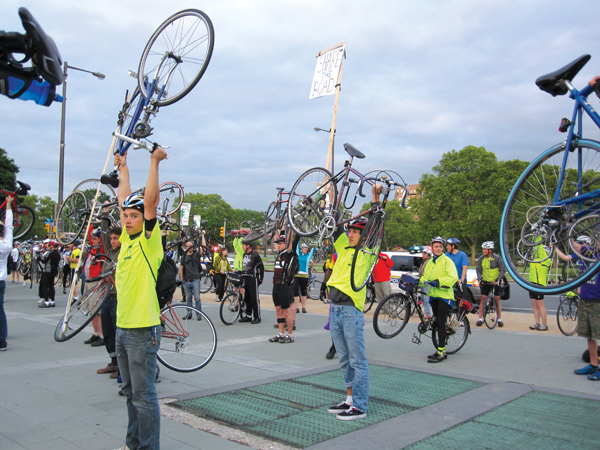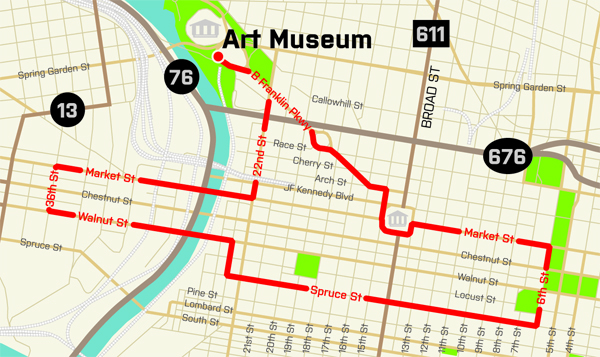
Julie Lorch pedals along with notable members of Philly’s bicycle community on a route of their choice. They ride, they chat, she reports back
Agroup of older gentlemen wearing bright yellow reflective vests stand to the left. Behind them are about a dozen kids sporting denim cutoffs and tattoos, leaning against their beat-up single-speeds. There are women from Sturdy Girl Cycling in hot pink spandex, ambassadors from the Bicycle Coalition passing around sign-in sheets and commuters eyeing each other’s sleek, small-wheeled folding bikes. Familiar faces from local shops and clubs are sprinkled throughout the crowd.
This diverse group of cyclists is gathered at the Art Museum steps to participate in the Ride of Silence, an annual event commemorating riders who have lost their lives on public roadways. The ride (which took place on May 20) also provides an opportunity to reflect on responsible riding habits.
The original Ride of Silence was inspired by the 2003 death of Larry Schwartz in Dallas, Texas. The gesture has since spread across the globe, with over 300 rides taking place in all 50 states and 25 countries. A second ride in our area was organized by Don Berk in Doylestown.
The evening begins with the voice of Ray Scheinfeld, one of the Ride’s organizers: “Cheryl Janzer, 50. Rick Clendaniel, 42. Anthony Hoffman, 51. William James Bradley V, 17. Edward Boye, 54. Robert Mitchell, 13. These are the names of the six Delaware Valley bicycle riders who were killed by motorists since we rode last year’s Ride of Silence.”
“We ride tonight to make this one point: We have the same right to use the roads as motorists,” continues John Siemiarowski, another organizer. “We need to remember that whenever we ride, we are ambassadors for all cyclists… I want to be able to say to a motorist, ‘We follow the rules, now you should too.’” He pauses: “We are not holding up traffic; we are traffic!” This statement draws applause and the high, bright chime of bike bells.
After a moment of silence, the only sound is the staccato click of shoes into pedals. The Ride starts with a cruise down Benjamin Franklin Parkway towards City Hall—the maximum speed is 12 mph, recalling a funeral procession. A police escort conducts rolling street closures, giving riders the full run of the road. Both the pace and silence are solemn, but the collective rhythm has its own energy, similar to heavy raindrops, the way the city feels in the middle of a downpour.
The six deaths that occurred this year in the Delaware Valley all took place outside the city limits. This might sound counterintuitive, but urban motorists are far more accustomed to sharing the road—whether they like it or not. According to the Bicycle Coalition of Greater Philadelphia, when the number of bikes on a street doubles, the crash risk for each individual declines by one third.
“Bicyclists have to follow rules, too!” screams a shrill voice on 10th Street. We are holding up north-south traffic as we pedal down Spruce. This man might be disrespectful, but he’s right.

The Ride heads north on 23rd Street. Ahead of me, I watch a steady stream of cyclists make a left onto Walnut Street. It’s dusk. Turning the corner, I see hundreds of riders crossing the bridge to West Philly. The orange light reflects off the river, the buildings, the bikes, the helmets; moving together, the riders look like a single sunset-hued organism. I say my first word in almost an hour: “Whoa.”
With a few final turns, we return to the steps of the Art Museum. Standing together, the assembled horde pauses for a final moment of remembrance, lifting bikes high in the air, and giving thanks for a safe ride through the city at dusk.
Cyclists Ray Scheinfeld and John Siemiarowski started the Philadelphia Ride of Silence in 2005 to commemorate the death of John’s friend Maurice Attie. Learn more about the Ride at rideofsilence.org.


